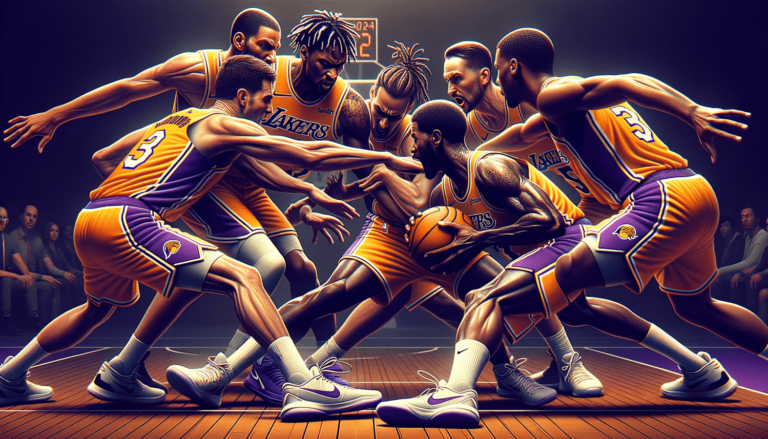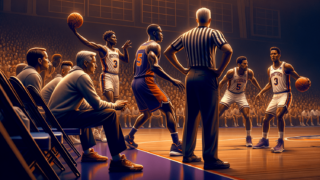
Offensive Foul Rule in Basketball: Key Points to Know
Written by: Basketball Universe
Last updated:

In the fast-paced world of basketball, there’s nothing quite as imposing as a player charging down the court, skillfully evading defenders on their way to the hoop. However, anyone truly familiar with the game knows that even the most impressive offensive maneuvers can be stopped in their tracks by the enforcement of the offensive foul rule. In this fun and professional blog post, we will delve into the key points you need to know about this crucial aspect of basketball’s rulebook, ensuring that whether you’re a casual fan or a courtside connoisseur, you’ll be able to appreciate the impact of the offensive foul rule on your favorite team’s performance.
Offensive Foul Rule in Basketball: Key Points to Know
The offensive foul rule in basketball refers to a violation committed by offensive players, resulting in a turnover and a change in possession. Key points to know include: (1) offensive fouls frequently occur when a player with the ball charges into a stationary defender; (2) away-from-the-ball fouls like illegal screens or pushing off defenders also qualify; (3) offensive fouls do not lead to free throws for the other team; (4) the defender must establish legal guarding position to draw an offensive foul; and (5) legal guarding position requires the defender to have both feet on the ground and facing the opponent before any contact is made.
Understanding the Basics of Offensive Fouls
Before diving into the complexities of the offensive foul rule, it’s important to understand the basics of why such rules exist in basketball. A well-rounded understanding of basketball rules begins with the very premise of keeping the game fair and enjoyable. Thus, offensive fouls are in place to ensure that every player on the court adheres to the principles of fair play, sportsmanship, and safety, resulting in a more competitive and entertaining match for everyone involved.
Breaking Down Different Types of Offensive Fouls
There’s more to offensive fouls than just one specific violation. The complexity of the game gives rise to numerous scenarios in which an offensive player can be deemed as committing a foul. So, let’s break down the different types of offensive fouls to gain a clear understanding and improve our knowledge of this critical aspect of basketball.
Charging
Charging is one of the most common forms of offensive fouls observed in basketball. This occurs when an offensive player with the ball collides with a stationary or retreating defender. In essence, the offensive player “charges” into the defender, and rather than earning points, they’re called for a violation. Key to a charging call is the fact that the defender must have established legal guarding position, which means having both feet on the ground and facing the offensive player prior to any contact being made.
Illegal Screens
Another common offensive foul is the illegal screen, also known as an illegal pick. This occurs when an offensive player sets a pick, or screen, to block or impede a defender without being stationary. To execute a legal screen, the screener must be stationary, with their hands and feet away from the moving defender. Violations of this rule result in an offensive foul call and a turnover, changing the possession over to the opposing team.
Pushing Off
Pushing off is an offensive foul that occurs when a player pushes or wards off a defender with their hand, forearm or elbow while attempting to gain an advantage. This can happen when an offensive player is trying to create separation for a shot, pass, or drive to the basket. By using their limbs to create separation, the offensive player violates the rules of fair play, leading to an offensive foul call and a change of possession.
Hooking
Hooking is an offensive foul committed when a player uses their arm or elbow to hook, or lock, a defender’s arm when trying to get around a screen or make a move to the basket. This action gives the offensive player an unfair advantage by physically restraining their opponent and is, therefore, considered a violation.
3 Seconds in the Key
While not traditionally viewed as an offensive foul, the “3 seconds in the key” rule is an infraction committed by the offensive team. This rule prohibits a player from remaining (touching) the painted area (also called the key) for more than three consecutive seconds while the ball is inbounds and his team is in control of the frontcourt. If the offensive team violates this rule, the ball is turned over to the opposing team.
Noteworthy Ramifications of Offensive Fouls
Now that we have an extensive understanding of the types of offensive fouls, let’s delve into the ramifications of committing them during gameplay. As these infractions directly impact the course of the game, it’s crucial to know their consequences on both individual players and the team as a whole.
Impact on Personal and Team Fouls
When an offensive foul is called, not only does the player responsible for the violation receive a personal foul, but the team also receives a team foul. Accumulating too many personal fouls can lead to a player being disqualified from the game, making it important to be vigilant about avoiding these infractions. Additionally, too many team fouls in a single period can result in bonus free throws for the opposing team, impacting the outcome of a closely contested game.
Change of Possession and Scoring Opportunities
One of the most immediate and significant consequences of an offensive foul is a turnover, resulting in a change of possession. This impacts the offensive momentum of the team committing the violation and takes away a potential scoring opportunity. Additionally, frequent turnovers can cause a disruptive lack of rhythm and cohesiveness among teammates, making it crucial for players to minimize their offensive fouls throughout the game.
Impact on Player Playing Time and Effectiveness
Players who consistently commit offensive fouls can face reduced playing time as coaches seek to minimize the potential damage caused by these violations. Moreover, players burdened with foul trouble (accumulating too many fouls early in the game) might have to play more conservatively to avoid disqualification, which could reduce their overall effectiveness on the court.
Defensive Strategies for Drawing Offensive Fouls
While understanding the offensive foul rule is crucial for avoiding violations, it’s equally important for defenders to know how to draw offensive fouls from their opponents. A well-executed defensive strategy can lead to offensive foul calls, creating more opportunities for your team to regain possession and score.
Taking Charges
One of the most effective strategies for drawing offensive fouls is taking charges. This involves a defender establishing legal guarding position in the path of an attacking offensive player, absorbing contact and, as a result, causing the offensive player to be called for a charging foul. Effectively taking charges requires good anticipation, quick footwork, and the courage to withstand potentially hard collisions with aggressive offensive players.
Anticipating Illegal Screens
Another key defensive strategy is anticipation of illegal screens or picks. A defender can “sell” the contact by emphasizing the physical contact from the moving screener, potentially drawing an offensive foul. This requires a keen understanding of the opponents’ offensive patterns and plays, allowing the defender to be in the right position at the right time to maximize their chances of success.
Playing Active and Engaged Defense
Lastly, maintaining an active and engaged defensive stance often increases the likelihood of drawing offensive fouls like pushing off, hooking, or warding off. By applying consistent and aggressive pressure on offensive players, defenders can frustrate their opponents and bait them into making mistakes or committing fouls.
Final Thoughts on the Offensive Foul Rule in Basketball
As we’ve explored in-depth, the offensive foul rule is an essential part of basketball that serves to maintain fairness, competitiveness, and safety on the court. Mastering the different types of offensive fouls, understanding their ramifications, and knowing defensive strategies for drawing offensive fouls are crucial aspects for any player, coach, or avid fan. The key to truly appreciating the art and science of basketball lies in understanding the nuances and intricacies of its rules, so every charge taken, screen set, and hook avoided, adds another dimension to the enjoyment of this fantastic game.
Coaching and Training Techniques to Minimize Offensive Fouls
No player is above making mistakes or committing fouls. However, with proper coaching and training techniques, players can minimize their propensity to create offensive fouls while maximizing their skills and potential on the court. The following strategies can help guide coaches, trainers, and players in addressing common offensive foul scenarios:
Effective Ball Handling and Movement
Building players’ ball handling skills can help them navigate the court without initiating unnecessary contact. By becoming familiar with the proper techniques of dribbling, change of direction, and control over the ball, offensive players can smoothly maneuver around defenders without causing charging fouls or pushing off. Consequently, strong ball handling skills translate to an overall reduction in offensive foul violations.
Coaching Communication and Off-Ball Movement
Another key element to reducing offensive fouls is teaching players the importance of active communication and awareness of off-ball movement. This includes verbal and non-verbal signals between teammates, such as hand gestures or eye contact, to indicate intended actions. By fostering an environment that emphasizes communication, players can avoid making unnecessary and ill-timed movements and minimize away-from-the-ball fouls like illegal screens or moving picks.
Practice Drills That Emphasize Proper Screening Techniques
Illegal screens are a common violation in basketball due to the fine line between setting a good pick and crossing the boundaries of fair play. Including specific drills that emphasize proper screening techniques during practices can significantly help in reducing these types of offensive fouls. Work on the fundamentals of legal screen setting and teach players how to maintain an effective distance from defenders without initiating contact.
Emphasizing Post Play Fundamentals
Post players, who operate near the basket and sometimes in crowded situations, are particularly susceptible to offensive fouls like hooking or warding off. To minimize these violations, coaches should place an emphasis on players mastering the fundamentals of post play. These fundamentals include proper footwork, positioning, and body control during back down moves, drop steps, or spin moves. Encouraging players to rely more on these skills rather than tricks or overpowering moves will help minimize the risk of offensive fouls.
Understanding How Referees Determine Offensive Fouls
Grasping the nuances of how referees determine offensive fouls is key to an even deeper understanding of game dynamics. The following guidelines can shed light on the decision-making process officials employ for these critical calls:
Legal Guarding Position
As previously mentioned, legal guarding position is a crucial aspect of determining most offensive fouls. Referees will assess whether the defender established their position (both feet on the ground and facing the opponent) prior to contact. In situations where the official deems the legal guarding position to have been established, offensive fouls are likely to be called on the attacking player.
Degree of Contact
Contact is a natural part of basketball, but it is the degree of contact that referees must ascertain to determine if it warrants an offensive foul call. Straightforward situations, such as a charging player plowing into a stationary defender, are easy calls for officials. However, subtle contacts like a slight push-off, a quick hook, or a moving screener require careful judgment to gauge whether the contact significantly affects the defender’s ability to maintain their position or continue their defensive duties.
Referee’s Positioning and Line of Sight
The position and line of sight of referees can greatly influence their ability to spot offensive fouls. To enhance their ability to make accurate calls, a team of officials will be strategically positioned around the court, ensuring that each has optimal visibility of the action. Understanding these court positions and sightlines can help players become more aware of the potential impact their actions may have on official calls, especially in relation to offensive fouls.
Exploring Famous Offensive Fouls in Basketball History
Throughout the history of basketball, there have been countless memorable moments that hinged on game-changing offensive fouls. These decisive calls underscore the importance of mastering the offensive foul rule and its impact on a player’s performance, ultimately shaping the outcome of entire games and, on occasion, even championships. By exploring these famous offensive foul calls, fans and players alike can gain a deeper appreciation for the significance of these rules in the context of this beloved sport.
Frequently Asked Questions About Offensive Fouls in Basketball
Offensive fouls can be a fascinating topic for basketball aspirants and die-hard fans alike, and many queries often arise in relation to these rules. With that in mind, here are ten frequently asked questions, accompanied by concise answers to help deepen your understanding of the offensive foul rule in basketball and enhance your appreciation of the game.
1. What is the difference between an offensive and a defensive foul?
An offensive foul occurs when a player on the offensive team commits an infraction, such as charging, illegal screens, or pushing off. A defensive foul occurs when a player from the defensive team makes illegal contact with an offensive player, commonly during a shot attempt or while defending a player with the ball. Both result in a change of possession, but defensive fouls can also lead to free throws for the offensive team.
2. When does contact between players result in an offensive foul?
Contact is an inherent part of basketball, but it becomes an offensive foul when it gives the offensive player an unfair advantage, impedes a defender’s ability to maintain position, or endangers the safety of the players. Judging the legality of contact is often subjective and rests within the discretion of the referee.
3. Can an offensive foul be called on a player without the ball?
Yes, offensive fouls can occur away from the ball, such as when a player sets an illegal screen for a teammate or pushes off a defender to create space. These fouls, like all other offensive fouls, result in a turnover and a change of possession.
4. How many offensive fouls can a player commit before being disqualified?
In most leagues, a player is disqualified after accumulating five (college basketball) or six (NBA) personal fouls, regardless of whether they are offensive or defensive. Offensive fouls count toward a player’s personal foul total, so consistent offenders may face disqualification and be forced to leave the game.
5. Can an offensive player draw a foul on a defender by initiating contact?
While it’s possible for an offensive player to draw a foul on a defender by initiating contact, referees are becoming increasingly aware of such tactics and often penalize the offensive player for leaning in or swinging their limbs to create contact. To minimize the risk of offensive fouls, players should avoid exaggerating movements to induce a call from the referee.
6. Will shooting free throws ever result from an offensive foul?
No, shooting free throws never result from an offensive foul; instead, the opposing team gains possession of the ball to resume play. Free throws are typically awarded only after defensive fouls, depending on the total number of team fouls or the specific league rules.
7. How does an offensive foul affect team and personal foul counts?
An offensive foul adds to both the offending player’s personal foul count and the team’s foul count for the period. An accumulation of fouls can impact individual players, as they risk disqualification, and the team, as it determines the number of free throws awarded to their opponents due to bonus situations.
8. What happens when a player is called for an offensive foul during a made basket?
If an offensive foul occurs during a made basket, the basket is disallowed, and the play is whistled dead. The offensive team loses possession, and the ball is awarded to the opposing team, nullifying any points that would have been scored.
9. How can a defender avoid being called for a blocking foul when trying to draw an offensive foul?
To avoid being called for a blocking foul, a defender must establish legal guarding position by having both feet on the ground and facing the opponent before any contact is made. The defender should not be moving when the offensive player initiates contact, as this may lead to a blocking foul instead of drawing an offensive foul.
10. Can a player be called for both an offensive and defensive foul in the same play?
While rare, it is possible for a player to be called for both an offensive and defensive foul in the same play, such as when an offensive player pushes off a defender and then illegally defends their own shot attempt. Each foul is assessed individually and added to the player’s personal and team foul counts.
Featured Posts
- No pillar pages found.





